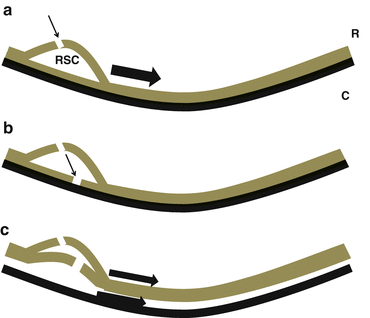(1)
St. Johns, FL, USA
(2)
Helen Keller Foundation for Research and Education, International Society of Ocular Trauma, Birmingham, AL, USA
(3)
Consultant and Vitreoretinal Surgeon, Milos Eye Hospital, Belgrade, Serbia
(4)
Consultant and Vitreoretinal Surgeon, Zagórskiego Eye Hospital, Cracow, Poland
57.1 General Considerations1
57.1.1 Anatomy and Pathophysiology
The typically bilateral lesion appears in the inferotemporal, occasionally superotemporal, quadrant, and results in an absolute scotoma as the layers of the neuroretina are split2 and the nerve connections are broken.3
Clinical recognition of the condition is somewhat difficult because a chronically detached retina bears some similarity to it, although the latter does not show the “beaten metal” appearance of a retinoschisis. OCT gives the definite answer in differential diagnostics.
The retinoschisis may be stationary or progressive; the latter may be partially explained by the fact that these eyes very rarely have a PVD, resulting in a constant, dynamic traction acting upon the inner wall of the cavity. RD may also develop if breaks are present both in the anterior and posterior walls of the retinoschisis cavity (see Fig. 57.1), and the RD may also be progressive.


Fig. 57.1




Schematic representation of the progression of retinoschisis. (a) With a break (thin arrow) in the inner wall of the retinoschisis cavity, there is a risk that the lesion spreads (thick arrow) toward the macula (not shown here). (b) With an additional break (thin arrow) in the outer wall of the retinoschisis cavity, there is a risk that the fluid from the vitreous cavity also spreads through the retina into the subretinal space. (c) What was only a threat on (b) has become a reality; now the macula is at risk from both the retinoschisis and a true RD (thick arrows). RSC retinoschisis cavity, R retina, C choroid
Stay updated, free articles. Join our Telegram channel

Full access? Get Clinical Tree


